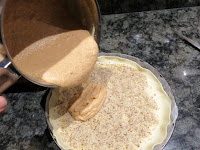This is something I
had kicking around for years in an earlier version somewhere in my notes. As it
has been foggy and cold for the last few days, I thought I’d revisit it as it
is rather too substantial for a summer dish. Needless to say, I didn’t have all
the same ingredients as for the original recipe, so think minus cauliflower and
carrots and with seabuckthorn instead of agave syrup if you want to try that
version out. It is quite quick (apart from the time it may take to do all the
chopping) as the sauce takes about as long to make as getting the pasta water to
boil and the pasta to cook. By the way, I love pasta that retain the sauce hence
my tendency to use conchiglie and fusilli for something like this.
What you need:
- 4 tblsp olive oil
- 300 g of broccoli, cauliflower and carrot, finely chopped
- 1 spoonful Madras curry masala
- 1 large onion also finely chopped
- 100 ml bubbly (Clairette or Moscato)
- 100 ml double cream
- 100 ml crème fraiche
- 1 tblsp agave syrup
- 2 cloves garlic (not pictured)
- salt or vegetable broth to taste
- 50 ml dry or medium dry sherry
- 400 g conchiglie


 What you do:
What you do:
- Sauté the onions in olive oil, add the Madras curry and allow the latter to brown a bit.
- Add the veggies and stir for about 2 to 3 minutes.
- Add the bubbly and allow it to reduce until the veggies are nearly dry.
- Add the two creams and leave it to simmer for about 5 minutes or until the sauce is quite creamy (the veggies will still have plenty of bite; if you want them soft, cook for longer and replenish with liquid, more bubbly, white wine or pasta water)
- In the meantime cook the conchiglie in salted water – about as salty as the med, an Italian told me – until they are al dente.
- Before serving add the garlic, squashed, the salt or veggie broth (instant or cube), bring to the boil briefly then add the sherry.
- Serve with some freshly grated parmesan or – my preference – pecorino romano.













